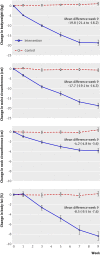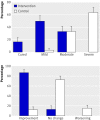Effect of a very low energy diet on moderate and severe obstructive sleep apnoea in obese men: a randomised controlled trial
- PMID: 19959590
- PMCID: PMC2788899
- DOI: 10.1136/bmj.b4609
Effect of a very low energy diet on moderate and severe obstructive sleep apnoea in obese men: a randomised controlled trial
Abstract
Objective: To assess the effect of weight loss induced by a very low energy diet on moderate and severe obstructive sleep apnoea in obese men. Design Single centre, two arm, parallel, randomised, controlled, open label trial. Blocked randomisation procedure used for treatment allocation. Setting Outpatient obesity clinic in a university hospital in Stockholm, Sweden. Participants 63 obese men (body mass index 30-40, age 30-65 years) with moderate to severe obstructive sleep apnoea (apnoea-hypopnoea index (AHI) >or=15), treated with continuous positive airway pressure.
Interventions: The intervention group received a liquid very low energy diet (2.3 MJ/day) for seven weeks to promote weight loss, followed by two weeks of gradual introduction of normal food, reaching 6.3 MJ/day at week 9. The control group adhered to their usual diet during the nine weeks of follow-up.
Main outcome measure: AHI, the major disease severity index for obstructive sleep apnoea. Data from all randomised patients were included in an intention to treat analysis (baseline carried forward for missing data). Results Of the 63 eligible patients, 30 were randomised to intervention and 33 to control. Two patients in the control group were dissatisfied with allocation and immediately discontinued. All other patients completed the trial. Both groups had a mean AHI of 37 events/h (SD 15) at baseline. At week 9, the intervention group's mean body weight was 20 kg (95% confidence interval 18 to 21) lower than that of the control group, while its mean AHI was 23 events/h (15 to 30) lower. In the intervention group, five of 30 (17%) were disease free after the energy restricted diet (AHI <5), with 15 of 30 (50%) having mild disease (AHI 5-14.9), whereas the AHI of all patients in the control group except one remained at 15 or higher. In a subgroup analysis of the intervention group, baseline AHI significantly modified the effectiveness of treatment, with a greater improvement in AHI in patients with severe obstructive sleep apnoea (AHI >30) at baseline compared with those with moderate (AHI 15-30) sleep apnoea (AHI -38 v -12, P<0.001), despite similar weight loss (-19.2 v -18.2 kg, P=0.55). Conclusion Treatment with a low energy diet improved obstructive sleep apnoea in obese men, with the greatest effect in patients with severe disease. Long term treatment studies are needed to validate weight loss as a primary treatment strategy for obstructive sleep apnoea.
Trial registration: Current Controlled Trials ISRCTN70090382.
Conflict of interest statement
Competing interests: None declared.
Figures




Comment in
-
Losing weight in moderate to severe obstructive sleep apnoea.BMJ. 2009 Dec 3;339:b4363. doi: 10.1136/bmj.b4363. BMJ. 2009. PMID: 19959587 No abstract available.
References
-
- Young T, Peppard PE, Gottlieb DJ. Epidemiology of obstructive sleep apnea: a population health perspective. Am J Respir Crit Care Med 2002;165:1217-39. - PubMed
-
- Young T, Palta M, Dempsey J, Skatrud J, Weber S, Badr S. The occurrence of sleep-disordered breathing among middle-aged adults. N Engl J Med 1993;328:1230-5. - PubMed
-
- Shaw JE, Punjabi NM, Wilding JP, Alberti KG, Zimmet PZ. Sleep-disordered breathing and type 2 diabetes: a report from the International Diabetes Federation Taskforce on Epidemiology and Prevention. Diabetes Res Clin Pract 2008;81:2-12. - PubMed
